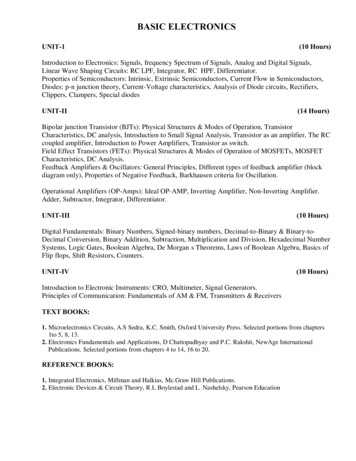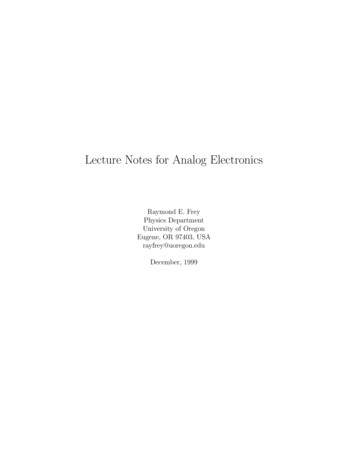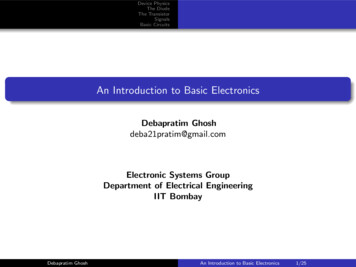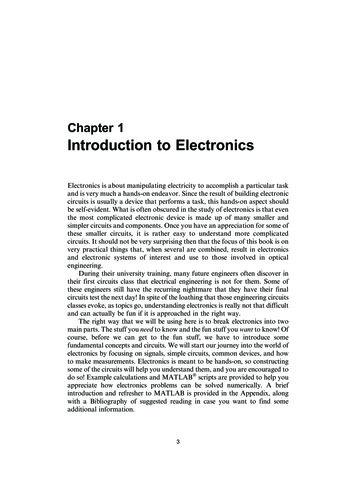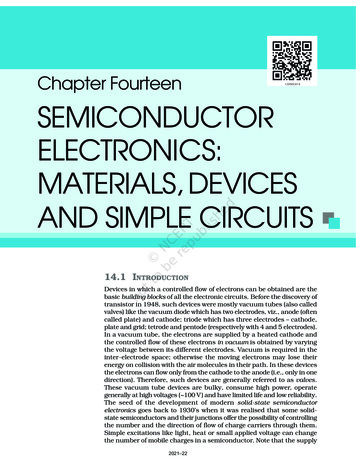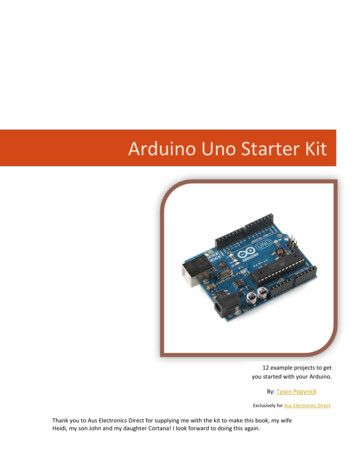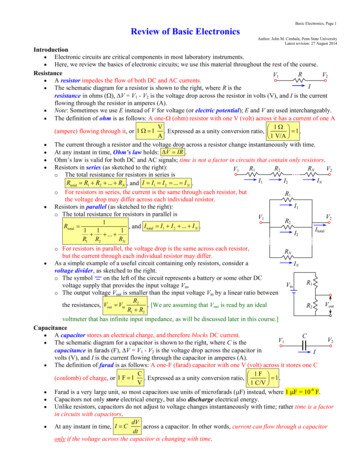
Transcription
Basic Electronics, Page 1Review of Basic ElectronicsAuthor: John M. Cimbala, Penn State UniversityLatest revision: 27 August 2014Introduction Electronic circuits are critical components in most laboratory instruments. Here, we review the basics of electronic circuits; we use this material throughout the rest of the course.ResistanceRV2V1 A resistor impedes the flow of both DC and AC currents.I The schematic diagram for a resistor is shown to the right, where R is theresistance in ohms ( ), V V1 - V2 is the voltage drop across the resistor in volts (V), and I is the currentflowing through the resistor in amperes (A). Note: Sometimes we use E instead of V for voltage (or electric potential); E and V are used interchangeably. The definition of ohm is as follows: A one- (ohm) resistor with one V (volt) across it has a current of one AV 1 (ampere) flowing through it, or 1 1 . Expressed as a unity conversion ratio, 1 .A 1 V/A The current through a resistor and the voltage drop across a resistor change instantaneously with time. At any instant in time, Ohm’s law holds: V IR . Ohm’s law is valid for both DC and AC signals; time is not a factor in circuits that contain only resistors. Resistors in series (as sketched to the right):R1R2RNV2V1o The total resistance for resistors in series isI1I2INRtotal R1 R2 . RN , and I I1 I 2 . I N .o For resistors in series, the current is the same through each resistor, butR1the voltage drop may differ across each individual resistor.I1 Resistors in parallel (as sketched to the right):o The total resistance for resistors in parallel isV2V1R21Rtotal , and I total I1 I 2 . I N .Itotal111I2 . R1 R2RNo For resistors in parallel, the voltage drop is the same across each resistor,RNbut the current through each individual resistor may differ. As a simple example of a useful circuit containing only resistors, consider aINvoltage divider, as sketched to the right.o The symbolon the left of the circuit represents a battery or some other DCR1Vinvoltage supply that provides the input voltage Vin.o The output voltage Vout is smaller than the input voltage Vin by a linear ratio betweenR2Voutthe resistances, Vout Vin. [We are assuming that Vout is read by an idealR2R1 R2voltmeter that has infinite input impedance, as will be discussed later in this course.]Capacitance A capacitor stores an electrical charge, and therefore blocks DC current.CV2V1 The schematic diagram for a capacitor is shown to the right, where C is the capacitance in farads (F), V V1 - V2 is the voltage drop across the capacitor inIvolts (V), and I is the current flowing through the capacitor in amperes (A).The definition of farad is as follows: A one-F (farad) capacitor with one V (volt) across it stores one CC 1F (coulomb) of charge, or 1 F 1. Expressed as a unity conversion ratio, 1.V 1 C/V Farad is a very large unit, so most capacitors use units of microfarads ( F) instead, where 1 F 10-6 F.Capacitors not only store electrical energy, but also discharge electrical energy.Unlike resistors, capacitors do not adjust to voltage changes instantaneously with time; rather time is a factorin circuits with capacitors.dVAt any instant in time, I Cacross a capacitor. In other words, current can flow through a capacitordtonly if the voltage across the capacitor is changing with time.
Basic Electronics, Page 2 Some consequences of the above statement:o For DC signals, there is no current flow through a capacitor, but there is a voltage drop. (The capacitoracts like an open switch – a switch that is turned off.)o For AC signals, the current through a capacitor changes as the voltage changes with time, according to theabove equation. At very high frequencies, AC signals easily pass through a capacitor, almost like a closedswitch. Capacitors offer little impedance to very high frequency signals.Capacitors block DC signals, but merely impede AC signals.C1CNC2Capacitors in series (as sketched to the right):o The total capacitance for capacitors in series isI1I2IN1I I I . ICtotal , and12N at any instant.C1111 . C1 C2CNI1o For capacitors in series, the current through each capacitor must beidentical, but the voltage drop may differ across each individual capacitor.C2Capacitors in parallel (as sketched to the right):Itotalo The total capacitance for capacitors in parallel is Ctotal C1 C2 . C N ,I2and I total I1 I 2 . I N at any instant in time.CNo For capacitors in parallel, the voltage drop is the same across eachcapacitor, but the current may differ across each individual capacitor.INInductance An inductor allows DC currents to flow, but impedes AC currents. An inductor is also called a choke when it is used in an electrical circuit to isolateLV2V1AC frequency currents, e.g., in a power supply filter. The schematic diagram for an inductor is sketched to the right, where L is theIinductance in henrys (H), V V1 - V2 is the voltage drop across the inductor in volts(V), and I is the current flowing through the inductor in amperes (A). The definition of henry is as follows: A one-H (henry) inductor has a one V (volt) drop across it when thecurrent is changing at the rate of one A/s (ampere per second),V 1 H A/s . Expressed as a unity conversion ratio, or 1 H 1 1.A/s 1V Like capacitors, inductors do not adjust to current changes instantaneously with time; rather time is a factor incircuits with inductors.dI At any instant in time, V Lacross an inductor. In other words, there can be a voltage drop across andtinductor only if the current through the inductor is changing. Some consequences of the above statement:o For DC signals, there is no voltage drop across the inductor, but there is a current flow. (The inductor actslike a closed switch – a switch that is turned on – basically, the inductor acts like a wire.)o For AC signals, the voltage drop across an inductor changes as the current changes with time, accordingto the above equation.L1L2LNV2V1 Inductors in series (as sketched to the right):I1I2INo The total inductance for inductors in series isLtotal L1 L2 . LN , and I I1 I 2 . I N at any instant.L1o For inductors in series, the current is the same through each inductor, butI1the voltage drop may differ across each individual inductor. Inductors in parallel (as sketched to the right):V2V1L2o The total inductance for inductors in parallel isItotal1I2Ltotal , and I total I1 I 2 . I N at any instant in time.111 . L1 L2LNLNo For inductors in parallel, the voltage drop is the same across each inductor,but the current through each individual inductor may differ.IN Inductors get a little tricky when they are physically close to each other. If
Basic Electronics, Page 3their magnetic fields interact with each other, there is an additional effect called mutual inductance. If themutual inductance is significant, the above equations for series and parallel inductors are no longer reliable.Impedance The word impedance is a general term implying that some quantity is slowed down or resisted. In electronics, impedance can be defined for resistors, capacitors, and inductors, since all of these electroniccomponents impede something. Impedance provides a way of combining the effects of resistance, capacitance, and inductance into oneproperty, and is thus a useful tool for analyzing and designing circuits. The units of impedance are the same as that of resistance – ohms. Let Z be the impedance of some electronic component. Z is a complex number. In this module, bold fonts areused to denote complex numbers. By definition, the absolute value (magnitude or modulus) of complex number Z is the ratio of peak voltage toVpeak, where Vpeak is the peak voltage or amplitude of an AC signal ( Vpeak V Vpeak) andpeak current, Z I peak Ipeak is the peak current ( Ipeak I Ipeak).Since there are phase shifts in AC signals, complex numbers are used to mathematically define impedance.To help you understand impedance, consider an input voltage signal consisting of a simple sine wave ofamplitude Vpeak, and with no phase shift or DC offset, Vin Vpeak sin 2 f t Vpeak sin t , where f is thefrequency in Hz, and is the angular frequency in radians/s.Consider the impedance of the three basic electronic components (resistor, capacitor, and inductor) in asimple circuit as shown to the right, where the symbolimplies a sinusoidal voltage input. Resistor:o The impedance Z for an ideal resistor is Z R , and it is real.Vino For a DC signal, 0, and Z R.o For an AC signal, 0, but still, Z R.Componento In other words, impedance is the same as resistance when considering a resistor.It does not matter whether the signal is AC or DC; the impedance of an idealresistor is always equal to the resistance R. Capacitor:1o The impedance Z for an ideal capacitor is Z , and it is imaginary. (Note: i 1 .)i Co For a DC signal, 0, and Z . In other words, an ideal capacitor has infinite impedance to a DCsignal, and acts like an open switch to DC currents – it completely impedes or blocks DC currents.o For an AC signal, 0, and Z is an imaginary number, inversely proportional to the frequency and to thecapacitance, as seen in the above equation – the capacitor impedes AC currents, but not completely.o As (very high frequency AC signal), Z 0. In other words, a capacitor offers very littleimpedance to high frequency AC signals. Inductor:o The impedance Z for an ideal inductor is Z i L , and it is imaginary.o For a DC signal, 0, and Z 0. In other words, an ideal inductor has no impedance to a DC signal, andacts like a closed switch to DC currents – it lets DC currents pass through unaffected.o For an AC signal, 0, and Z is an imaginary number, proportional to the frequency and proportional tothe inductance, as seen in the above equation – the inductor impedes AC currents, but not completely.o As (very high frequency AC signal), Z . In other words, an inductor has high impedance tohigh frequency AC signals – it nearly completely blocks high frequency AC currents. Comparing the effect of capacitors and inductors, inductors are somewhat opposite to capacitors (capacitorsoffer little impedance to low frequency AC signals but let high frequency AC signals pass, while inductorsgreatly impede high frequency AC signals, but let low frequency AC signals pass).Review of complex variables – See the learning module Review of Complex Variables for a general review.
Basic Electronics, Page 4Diodes A diode (also called a switching diode) allows current to flow in one direction, butCurrent flowsit impedes the flow of current in the opposite direction.this way onlyThe schematic diagram for a diode is shown to the right.V2V1o When current flows in the direction of the arrow symbol, we call it forwardbiased. An ideal diode has zero impedance in the forward biased mode.Io When current attempts to flow in the direction against the arrow symbol, weV2V1Icall it reverse biased. An ideal diode has infinite impedance in the reversebiased mode.Equivalent circuitFor an ideal diode with current flowing in the allowed direction (forward biased),the voltage does not drop across the diode: V V1 – V2 0. Thus, the equivalent circuit is a closed switch orshort circuit (just a wire between 1 and 2), as sketched to the right.A real diode, however, creates a small voltage drop in the circuit.If V V1 – V2 0, in other words if V2 V1, then current attempts to flow throughCurrent cannotan ideal diode in the opposite direction (reverse bias). However, the diode does notflow this wayV2V1permit current to flow that way (opposite to the direction of the arrow in theschematic diagram). Thus, the equivalent circuit is an open switch or open circuitI(no connection between the two leads of the diode), as sketched to the right.V2V1A real diode, however, has a small leakage of current through the diode.Procedure for the analysis of a circuit containing an ideal diode:Equivalent circuito Assume that the diode is operating in forward bias mode; in other words,replace the diode with a short circuit.o Evaluate the circuit and calculate the direction of current flow through the diode.o If the calculated current is in the forward bias direction (in the direction of the arrow), then the analysis isvalid, and nothing further needs to be done.o If the calculated current is in the reverse bias direction (in the direction opposite of the arrow), then theanalysis is invalid. Replace the diode with an open circuit, force the current to be zero, and re-analyze thecircuit.Example:Given: The circuit shown to the right.To do: Calculate the current through the diode for two cases: (a) V1 V2,and (b) V2 V1.Solution: We follow the procedure outlined above.(a) We assume that the diode is in forward bias mode, and replace theV1R1V1R1diode with a short circuit. Ohm’s law yields V1 V2 I R1 R2 or I IR2V2R2V2Equivalent circuit V1 V2 . Since V1 V2, the R1 R2 predicted current I 0, and our assumption is valid. Current flows as indicated on the diagram.(b) The same analysis applies. However, since V2 V1, the predictedR1R2V1current I 0, and our assumption is not valid. We therefore replacethe diode with an open circuit, for which I 0 .IR1R2V1Discussion: This analysis is for ideal diodes only. A real diode wouldEquivalent circuithave a small voltage drop for Part (a), and would have a small currentleakage for Part (b).LEDs A light emitting diode (LED) is simply a switching diode that gives off lightwhen the diode operates in the forward bias mode.LEDs have been in the news lately because they are now used in light bulbs. Itturns out that LED light bulbs are more efficient than incandescent orfluorescent light bulbs, and last longer. They are especially good for flashlights.Transistors [This section originally authored by Alison Hake as part of an honors option for M E 345] A transistor is a device that contains three layers of two semiconducting materials that can be used as aswitch (or relay), an amplifier, or a detector.V2V2
Basic Electronics, Page 5 If the transistor is being used to amplify DC current, the gain of the amplification is notated as HFE. This valueis typically found on the data sheet for each specific type of transistor, and is typicallyconsidered constant, however slight variations exist in HFE due to changes intemperature, collector to emitter voltage, and collector current.Generally transistors look like the picture to the right, however, they can be made to bevery small and incorporated into integrated circuits.Transistors are classified based on the order of the conducting material layers. It ispossible for a transistor to be an NPN configuration or a PNP configuration, where theN-type semiconductor conducts negative charge and the P-type semiconductor conducts positive charge. NPNand PNP are also referred to as polarities.The three prongs on the transistor are known as the base, the collector, and the emitter. In an NPNconfiguration, the collector serves as the input, the base is the control, and the emitter is the output. In a PNPtype transistor, the collector and the emitter switch roles, so the emitter is the input, the base is the control,and the collector is the output.Typeso The most common transistors are TIP29/31, TIP30/32, and TIP122. Each is discussed below.o TIP 29/31 NPN-type; the circuit diagram for this type of transistor is shown to the right. Maximum emitter-base voltage 5 V, maximum collector-emitter voltage 80volts, and maximum collector-base voltage 40 volts. HFE 15 to 75, depending on the voltage across the collector and emitter andthe collector current.o TIP 30/32 PNP-type; the circuit diagram for this type of transistor is shown to the right. Maximum emitter-base voltage -5 V, maximum collector-emitter voltage -40 V, and maximum collector-base voltage -40 V. HFE 15 to 75, depending on the voltage across the collector and emitter andthe collector current.o TIP 122 NPN-type; the circuit diagram for this type of transistor is shown to the right. Maximum emitter-base voltage 5 V, maximum collector-emitter voltage 100 V, and maximum collector-base voltage 100 V. HFE 1000. The TIP122 transistors are useful in applications where large voltage andcurrent amplifications are needed since HFE is so large.Sinking and sourcingo Since transistors can act as switches, they can be useful for sinking and sourcing currents.o If there is a voltage and current supply to a load that is in series with a transistor to ground, then thetransistor is sinking the current through the load to the ground.o If there is a voltage and current supply passing through a transistor in series with a load and a ground,then the transistor is sourcing the current from the power supply to the load before it goes to ground.Phototransistorso A phototransistor is a light sensor that is formed from a basic transistor but that isspecially designed to create a gain based on the amount of light that is absorbed.o In a circuit diagram, a phototransistor looks like the image to the right.Use in place of relayso A relay is a device that contains an inductor or electromagnet that, when activated bya voltage and current, creates a magnetic field that flips an internal mechanicalswitch. Once the switch is flipped, a higher voltage can be output from the device.o Since there is a mechanical switch that actually moves inside the device, relays wear out much faster thanother types of switches. They are also loud, as a “click” can be heard when the switch flips.o Transistors have replaced the use of relays in many cases. They are smaller and much more durable, yetthey perform the same function when wired correctly.
Basic Electronics, Page 2 Some consequences of the above statement: o For DC signals, there is no current flow through a capacitor, but there is a voltage drop. (The capacitor acts like an open switch – a switch that is turned off.) o For AC signals, the current through a capacitor changes as the vo




